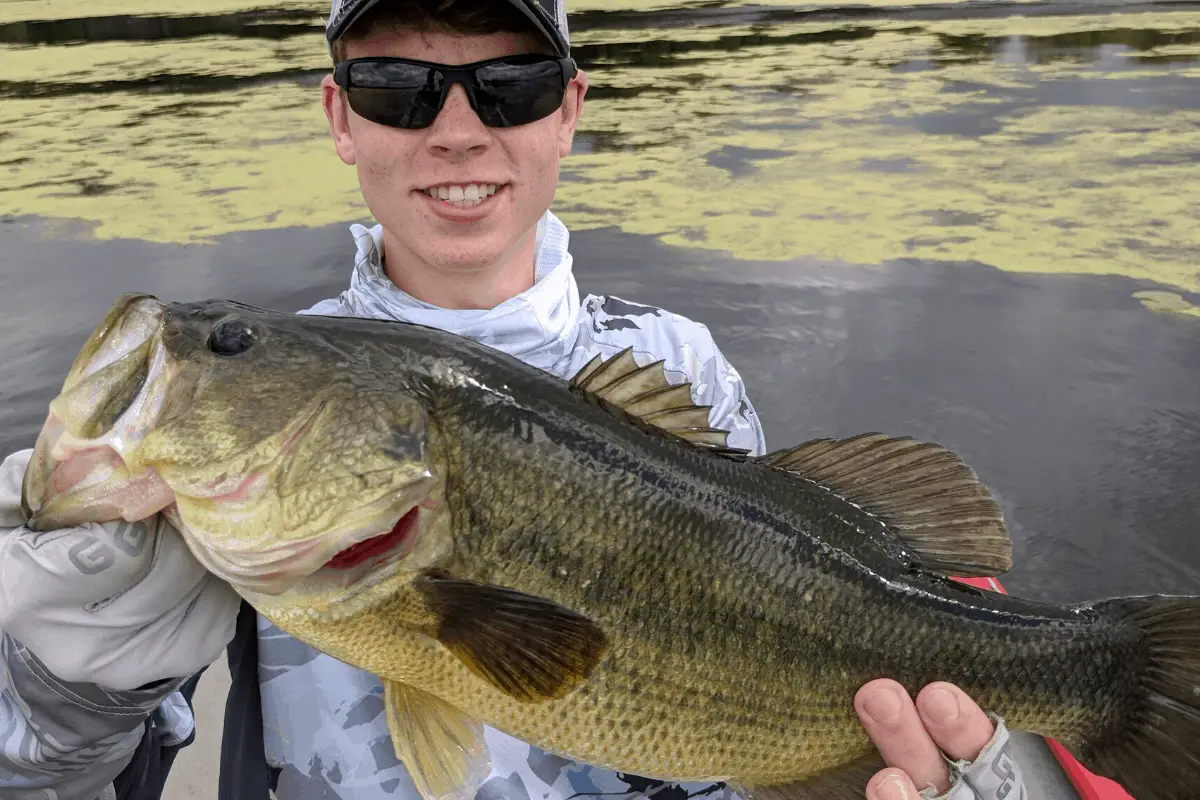Ask 100 bass anglers, you may get 100 answers, but with all seriousness, there are lures that traditionally out perform others. In this list, I am going to suggest lures that work well and are easy to fish. They have a small learning curve which will help you put more bass in the boat quicker.
Some of the most effective lures, that are also quick to learn, are: the swim jig, a square-billed crankbait, the Ned rig, a wacky rigged stick bait, and the soft plastic jerkbait.
In this article, I will discuss each of these lures and methods in detail. When finished, you should be confident in these baits whether you are a beginner or more advanced angler.
Why These Five Lures?
I have assembled this list based on my experience from over twenty years of working within the bass fishing industry, thousands of hours on the water, hosting numerous television shows, and spending many days on the water with some of the best bass anglers on the professional tournament circuits. So let’s get started.
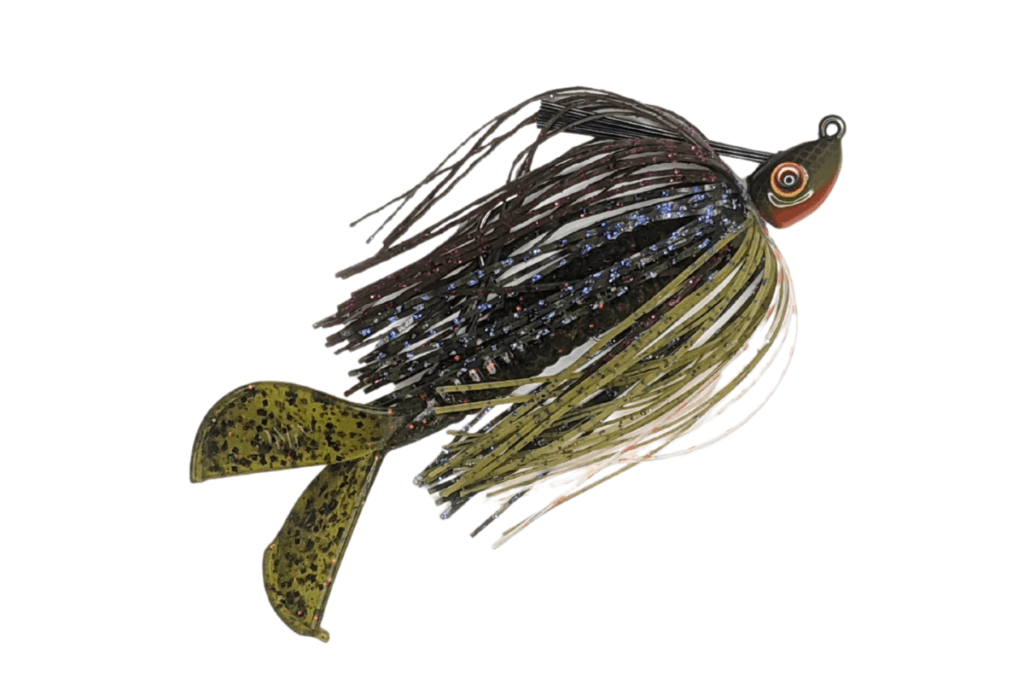
The Swim Jig
This lure, by far, is my favorite go-to just about any time of the year. It works. It catches numbers. It catches big fish and it usually generates arm-ripping strikes.
The Jig
First, a swim jig is different than a flipping jig. The head is designed with a narrow profile to help maintain proper horizontal tracking through the water column. This slender head design also cuts through vegetation with ease.
I like to start with a ¼ oz version in some sort of natural color. For many of you, that may be some variation of white. For my home lake, I like to use a bluegill colored swim jig since that is the main forage base where I spend a lot of time. If the waters you fish have some color to them, or are even dirty, you may start with black-blue.
The Trailer
Choose a soft plastic trailer that matches the jig itself. I use a twin-tail grub 99% of the time. It helps to displace a lot of water and lets me fish the jig slow without sinking. Other popular soft plastic trailers include paddle tail swimbaits, grubs, or even a straight tailed worm.
The trailer adds additional action to the presentation and helps to entice those wary fish to commit.
The Line and Rod
I throw the swim jig on 10lb test line and I have used mono, fluorocarbon, and braid all with great success. Match the line to the water conditions that you have.
My rod is a 7’3” Medium Heavy with a fast tip. I have also used a Medium action, but prefer the heavier setup. Why? I fish the swim jig around lots of thick vegetation and I like the extra winching power the slightly heavier rod affords me.
The Presentation
My presentation is simple, but if you would like to see three different highly effective swim jig presentations, check out the video here.
Tom Monsoor, the undeniable swim jig guru, says this phrase when fishing a swim jig, “Float like a butterfly, sting like a bee.”
You may have heard that before. He says this because it helps him to swim the jig as slow as possible without sinking in the water column. Pulse the rod as you fish, it gives the look of a baitfish that is struggling to stay afloat. Get ready, because you are about to get bit!
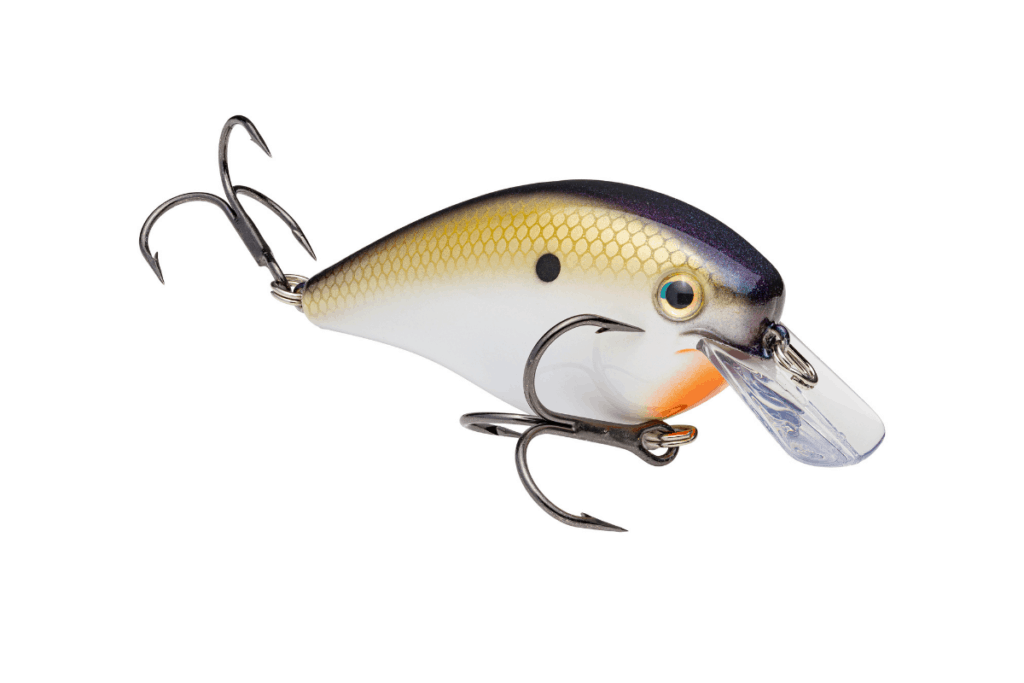
Square-Billed Crankbait
If you are naturally drawn to crankbaits, then this is one that you must have in your lineup. It works in a variety of conditions and is excellent at locating groups of bass.
The Lure
It’s no mystery where this bass lure gets its name from. The bill is short, stubby, and is square-shaped.
This style of plastic bill is masterful at working its way up, over, and around all sorts of nasty stuff that bass love to hang around. The bill design, paired with the body, also creates a wonderful “hunting” action that bass find enticing even when fished in open water.
Square-billed crankbaits come in a variety of sizes and you will want to choose one based on the depth you wish to target.
Color Selection
Just like the swim jig, most color choices revolve around the baitfish that are natural to your home waters. If you have lots of bluegill, like I do, then firetiger is a great selection.
Square-billed crankbaits also come in a wide range of crawdad patterns. This type of crankbait bangs and crawls off of rocks well. Crawdads love to hide in the rock, so a square-bill is a natural choice here. Do your best to match the color of the lure to the color phase of the crawdads. Flip a few rocks around the boat ramp to see if the little crustaceans are sporting brown, green, or red hues.
The Rod, Reel, and Line
All of my crankbaits rods are Medium in action and are composite. In other words, I do not like pure graphite rods for crankbait fishing. I prefer models that are a combination of graphite and glass, as in fiberglass.
I tend to stick with low gear ratio reels, like a 5.2:1. This forces me to slow down the presentation and not crank the lure in too quickly and for most of my cranking I stick with 10lb mono, although I do use fluoro on occasion.
The Presentation
When it comes to presentation, keep it simple. Bang and bounce this lure into everything you can find. Rip it through grass, crawl it over logs, bounce it off stumps and pound it into rocks. Be ready for bites on the deflection or once you rip it free from vegetation. It really is that simple.
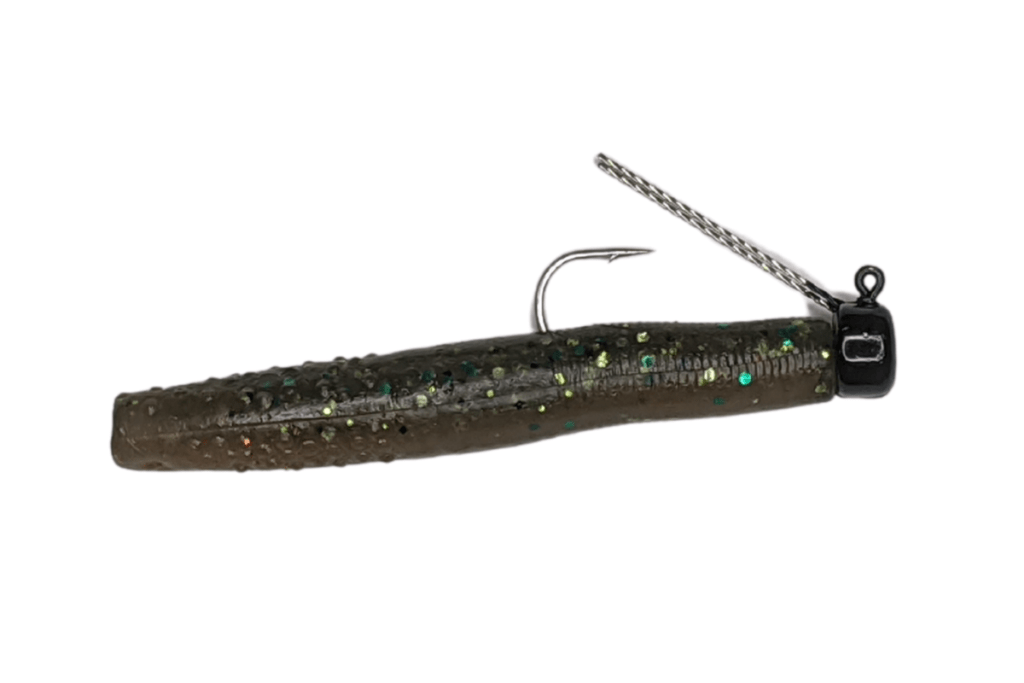
The Ned Rig
Popularized by Ozark angler and outdoor writer, Ned Kehde, this ultra-simplistic lure just works.
The Lure
The most popular Ned Rig lure is a shortened stick bait. If you have a bag of 5” Senkos, cut one in half, and you are set.
With the popularity of this lure though, about every manufacturer has something in their catalog that is considred a Ned Rig bait. I know it looks like the lure will do nothing, but that is the point. It is an ultra finesse lure and presentation that fools bass of all sizes.
Color Selection
Since I normally fish the Ned Rig in clear or slightly stained water, I keep my color selection process to natural offerings. If you had to choose only two though, I would stick with green pumpkin and some sort of watermelon. If you would like to expand out from there, whites, silvers, and other translucent natural colors work well.
Weight
Ned Rig weights are some of the smallest that you will ever see. Most companies offer them in the following sizes: 1/10 oz, ⅙ oz, ⅕ oz, and ¼ oz.
The weight selection is determined by the depth you are going to fish and the intensity of the wind. I go as light as I can, but if the lure takes forever to sink because I am fishing really deep, like 40ft of water, I will increase the size of the jighead. Same if the wind is blowing hard. Maintaining contact with the lure is critical to feeling bites.
The Rod, Reel, and Line
Since the lure is so tiny, this presentation is pretty much restricted to spinning gear. I prefer a medium action rod with a fast tip. Most of the time I am making long casts with my Ned Rig, so I like a rod that is 7’ or slightly longer.
I keep the line as light as I can, anywhere from 6 – 8 lb test. Either monofilament or fluorocarbon works. If I am fishing deep, I will go with straight fluoro or braided line with a fluoro leader. Mono has lots of stretch in it and if my lure is way down there, that extra stretch may mean missed fish on the hooksets. Fluoro is low stretch and transfers the energy straight to the hookset.
Speaking of the hookset, no arm-ripping power swing is needed here. Just reel down and apply tension with a steady side sweep of the rod. These ultra-light hooks will penetrate the fish’s mouth easily.
The Presentation
There are a five different presentations that work well with the Ned Rig. You can watch this video here if you like. It goes over all five in detail.
My go-to presentation though is as follows: 1) cast the lure out; 2) let in sink and slightly shake it on the way down; 3) let it hit bottom and then shake it in place; 4) reel your line in and repeat the process.
Many of your bites will come on the initial drop. Watch your line and if it twitches or swims off be sure to set the hook.
My next favorite presentation starts off the same, but when it gets to the reeling in process, be sure to drag the lure along the bottom. You can either reel in very slowly and maintain bottom contact, or you can side-sweep with your rod to move the lure and then use the reel to bring in the slack line after you sweep it.
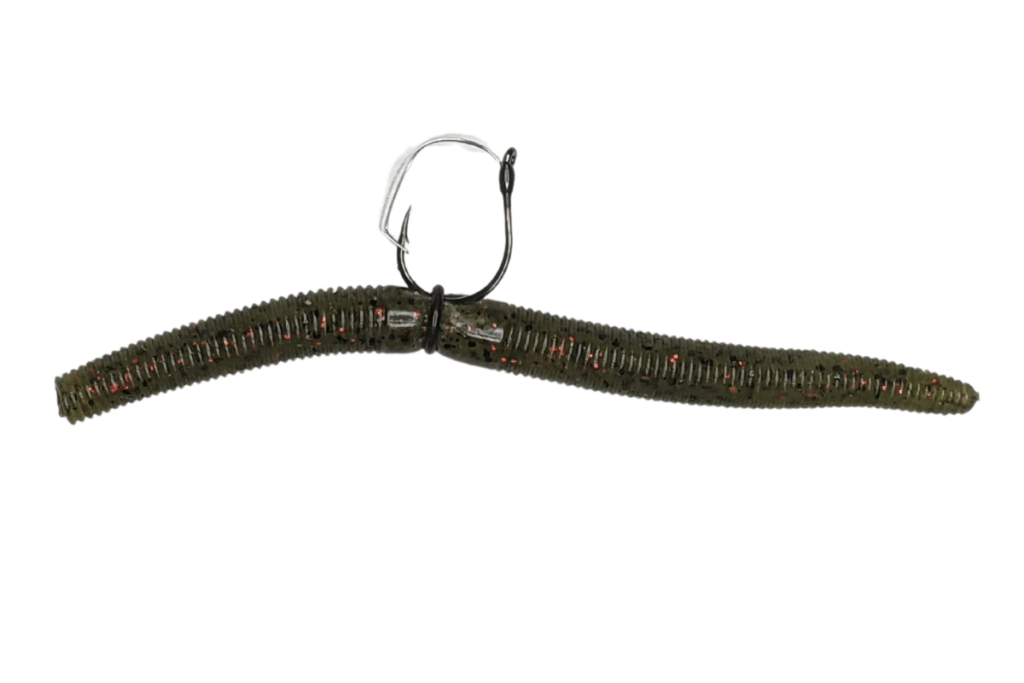
Wacky Rigged Stickbait
A “Senko” style stick bait hooked up with a wacky rig is a staple for anglers of all ages and all experience levels. Beginners to seasoned pros will count on this bait and presentation to bring fish in and, yes, it does.
The Lure
Gary Yamamoto designed this lure by looking at a Bic pen. He thought he created a new type of a soft jerkbait, but while fishing for spawning bass one day, he realized the power of this simple lure.
Most stick baits come in the 5” range for their staple size, yet there are smaller and larger versions available.
Color Selection
As with most color choices, if you go with natural choices in clear water and more solid colors, like black-blue for stained and dirty water, you will be in great shape.
It is popular to add some chartreuse to one end of a stick bait. It draws attention to the nice shimmy the lure has on the drop. You can either use some chartreuse dye or buy stickbaits with chartreuse ends to them.
The Hook and Weight
Wacky Rigging a stick bait can be as simple or complicated as you want it to be. I first started by using a insert tube jighead. I have caught hundreds of bass this way. I liked this style of jighead because they are inexpensive and I can change weights easily if I am fishing in current or heavy wind.
If you plan to go completely weightless, which is what anglers prefer 90% of the time, then your hook options become almost endless. I have used a lot of VMC wacky rig hooks, both with and without the weedguard.
Using O-Rings
One of anglers biggest complaints with the stick bait, or Senko style bait, has to be its durability. It is not unusual to go through several bags of lures during an outing, unless you are using a model made from Elaztech. Like the Z-Man models or the Zero from Strike King.
Savvy bass anglers have designed several different types of o-rings and o-ring tools to help keep these lures from tearing so easily and being wasted. I myself, love to use o-rings and have found them to be a worthy addition to my wacky rig setup. (See Photo)
The Rod, Reel, and Line
I have fished the wacky rig on both spinning and baitcast equipment. I prefer spinning gear in relatively open situations where I am not trying to pitch the lure into a really small area. If accuracy is the top priority, then I will switch over to baitcast equipment.
For either rod, I like a medium heavy action and pair it with a high speed reel in the 7:2.1 range. Some manufacturers even have designed rods just for this technique.
As far as line, I have used everything you can think of. When fishing dirtier water with current, like the MIssissippi, I spool on braid. If I am fishing gin-clear water I go with something in the 8lb test range and tie a fluorocarbon leader on.
The Presentation
The genius of a Wacky Rigged stick bait is in the fall. Make sure the lure drops on a slack line and let that magical shimmy do its thing. Many of the strikes will come on this initial drop which is why it is so popular to fish this rig weightless.
Once the lure hits bottom, twitch it a couple of times and then give it a good pop with the rod. This will rocket the lure off the bottom. Then let it drop on a slack line again.
You can change colors and see which one is the recipient of the best strikes. A wacky rigged stick bait is one area where I believe color can make a huge difference because the bass see it real well as the lure drops. If you have a partner in the boat, each of you use a different color and narrow down the best bait together.
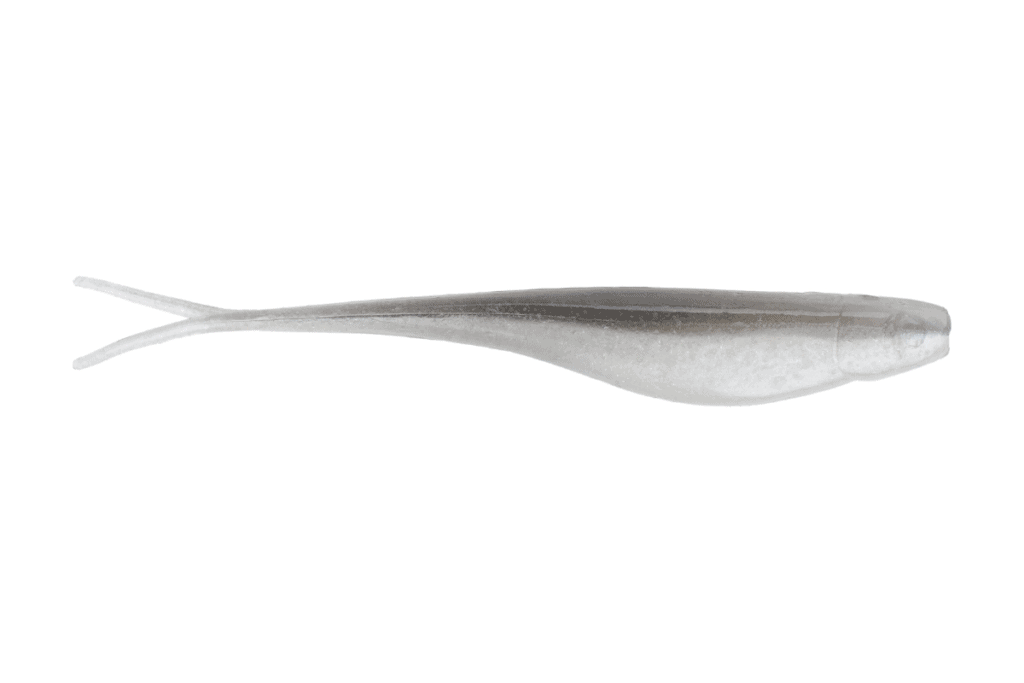
Soft Jerkbait
Man, I love this lure. The purpose of a soft jerkbait is to imitate baitfish. These could be shad, alewives, bluegill, perch, or a host of other fish that bass love to prey on.
There are hard bodied jerkbaits on the market, but the lures I am referring to in this article are made from soft plastic. The benefit to this design is that it can be fished anywhere without the worry of getting hung up on something.
The Lure
Most companies offer a wide range of soft jerkbaits in both size and color. The 5” version is considered the gold standard, you can go up and down from there. I would start with the 5” offering.
Soft jerkbaits will come with two different types of tails: straight tail or paddle tail. The first is more conducive to twitching, jerking, and slithering through vegetation. The paddle tail is more often “swam” on a more traditional straight retrieve.
For the rest of this section, I will be referring to the straight tail version.
Color Selection
For the soft jerkbait, stick with something that matches the baitfish in your home waters. Whites, silvers, and grays are the standard go-to choices for most anglers. If you are fishing waters, like Lake Champlain, that are busting at the seams with yellow perch, then try a soft jerkbait in a watermelon color.
The Rod, Reel, and Line
I throw soft jerkbaits on baitcast gear almost exclusively. I like a medium action rod with a fast taper at the tip. The length is really up to you. I prefer something in that 7’4” range because I am usually making long casts with this lure and want some extra leverage to get the bait way out there.
I love to use a middle of the road reel, a 6.2:1 is great. This is my choice because sometimes I fish it slow and deliberate and other times I am ripping the lure quickly across the surface of the water.
I prefer monofilament for my soft jerkbait rod because I want the lure to stay near the surface. Mono floats much better than fluorocarbon. If the situation demands that I am fishing through lots of emergent vegetation I will then switch to braid because it cuts through the green stuff real well.
Rigging
I Texas rig soft jerkbaits and lay the hook across the back, or what is called “Tex-pose.” The hook point does not have to fight through the plastic this way and I get much better hooksets.
A 3/0 or 4/0 hook works well. Adjust up or down based on the size of the lure you are using.
If you want to fish deeper, like if you are trying to target the top of a submerged weedbed, place a worm weight ahead of the hook.
The Presentation
I rely on two different presentations. The first is the typical twitch and jerk retrieve. The goal is to make the lure appear like a baitfish that is not feeling well, or sick, and presents itself as an easy meal.
The second presentation is my favorite. I call it the “fleeing baitfish.” If you have ever witnessed a bass chasing minnows, you know exactly what I am trying to imitate here. The minnow will literally dart out of the water to avoid being devoured.
I do the same thing with the soft jerkbait. I hold the rod tip high and bounce the lure across the top of the water. I will then let it sit for a second and then repeat. This drives bass crazy because it turns on the predatory feeding instinct.
I have watched bass dart out from under a dock and rocket forty feet away to demolish a soft jerkbait presented in this manner. It is so much fun!
The Hookset
Many times, you will see the bass inhale the lure. Do not set the hook too early. Make sure you feel some weight first and then apply pressure with a good side sweep of the rod.
Final Thoughts
This list of my five favorite bass fishing lures that actually work are also easy to fish. A beginner can pick any of them up and be on the way to success in a short amount of time.
As you grow as an angler, there are many variations to the above lures that can be made. Have fun with them. Try something a little different. Who knows? You just may be onto the next big thing in the bass fishing world.
Tight lines!

